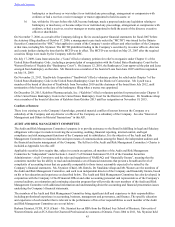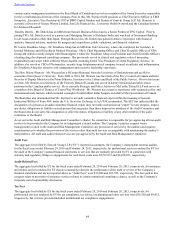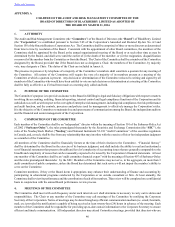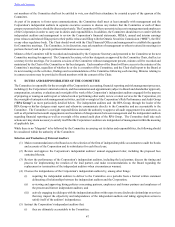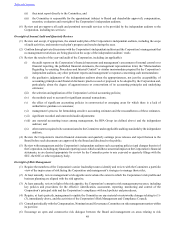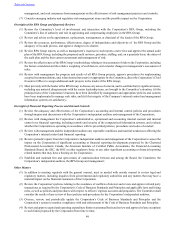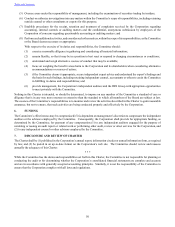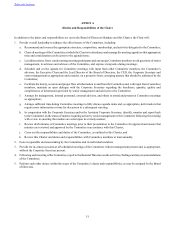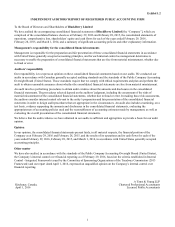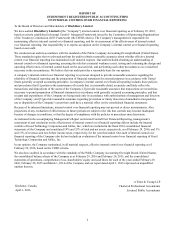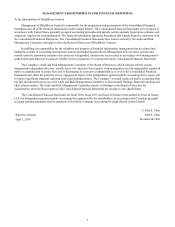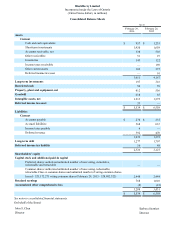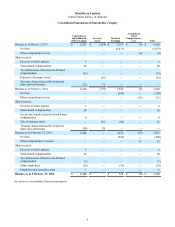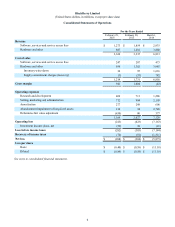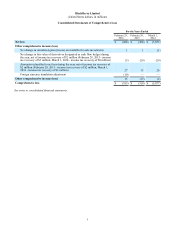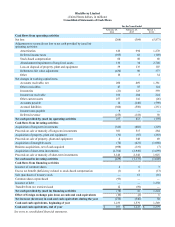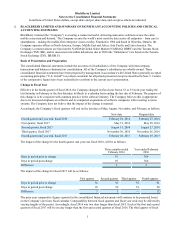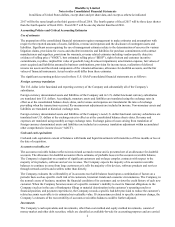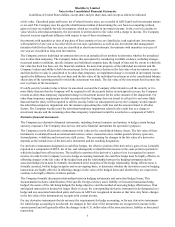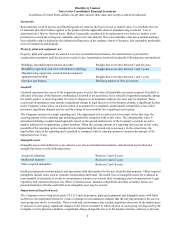Blackberry 2016 Annual Report Download - page 62
Download and view the complete annual report
Please find page 62 of the 2016 Blackberry annual report below. You can navigate through the pages in the report by either clicking on the pages listed below, or by using the keyword search tool below to find specific information within the annual report.2
REPORT OF
INDEPENDENT REGISTERED PUBLIC ACCOUNTING FIRM
ON INTERNAL CONTROL OVER FINANCIAL REPORTING
To the Board of Directors and Shareholders of BlackBerry Limited
We have audited BlackBerry Limited’s [the “Company”] internal control over financial reporting as of February 29, 2016,
based on criteria established in Internal Control - Integrated Framework issued by the Committee of Sponsoring Organizations
of the Treadway Commission (2013 Framework) (the COSO criteria). The Company’s management is responsible for
maintaining effective internal control over financial reporting, and for its assessment of the effectiveness of internal control
over financial reporting. Our responsibility is to express an opinion on the Company’s internal control over financial reporting
based on our audit.
We conducted our audit in accordance with the standards of the Public Company Accounting Oversight Board (United States).
Those standards require that we plan and perform the audit to obtain reasonable assurance about whether effective internal
control over financial reporting was maintained in all material respects. Our audit included obtaining an understanding of
internal control over financial reporting, assessing the risk that a material weakness exists, testing and evaluating the design and
operating effectiveness of internal control based on the assessed risk, and performing such other procedures as we considered
necessary in the circumstances. We believe that our audit provides a reasonable basis for our opinion.
A company’s internal control over financial reporting is a process designed to provide reasonable assurance regarding the
reliability of financial reporting and the preparation of financial statements for external purposes in accordance with United
States generally accepted accounting principles. A company’s internal control over financial reporting includes those policies
and procedures that [1] pertain to the maintenance of records that, in reasonable detail, accurately and fairly reflect the
transactions and dispositions of the assets of the Company; [2] provide reasonable assurance that transactions are recorded as
necessary to permit preparation of financial statements in accordance with generally accepted accounting principles, and that
receipts and expenditures of the Company are being made only in accordance with authorizations of management and directors
of the Company; and [3] provide reasonable assurance regarding prevention or timely detection of unauthorized acquisition,
use or disposition of the Company’s assets that could have a material effect on the consolidated financial statements.
Because of its inherent limitations, internal control over financial reporting may not prevent or detect misstatements. Also,
projections of any evaluation of effectiveness to future periods are subject to the risk that controls may become inadequate
because of changes in conditions, or that the degree of compliance with the policies or procedures may deteriorate.
As indicated in the accompanying Management’s Report on Internal Control Over Financial Reporting, management’s
assessment of and conclusion on the effectiveness of internal control over financial reporting did not include the internal
controls of Good Technology Corporation and AtHoc, Inc., which are included in the fiscal 2016 consolidated financial
statements of the Company and constituted 19% and 23% of total and net assets, respectively, as of February 29, 2016, and 3%
and 13% of revenues and loss before income taxes, respectively, for the year then ended. Our audit of internal control over
financial reporting of the Company also did not include an evaluation of the internal control over financial reporting of Good
Technology Corporation and AtHoc, Inc.
In our opinion, the Company maintained, in all material respects, effective internal control over financial reporting as of
February 29, 2016, based on the COSO criteria.
We also have audited, in accordance with the standards of the Public Company Accounting Oversight Board (United States),
the consolidated balance sheets of the Company as at February 29, 2016 and February 28, 2015, and the consolidated
statements of operations, comprehensive loss, shareholders’ equity and cash flows for each of the years ended February 29,
2016, February 28, 2015 and March 1, 2014 of the Company and our report dated April 1, 2016 expressed an unqualified
opinion thereon.
/s/ Ernst & Young LLP
Kitchener, Canada, Chartered Professional Accountants
April 1, 2016 Licensed Public Accountants


